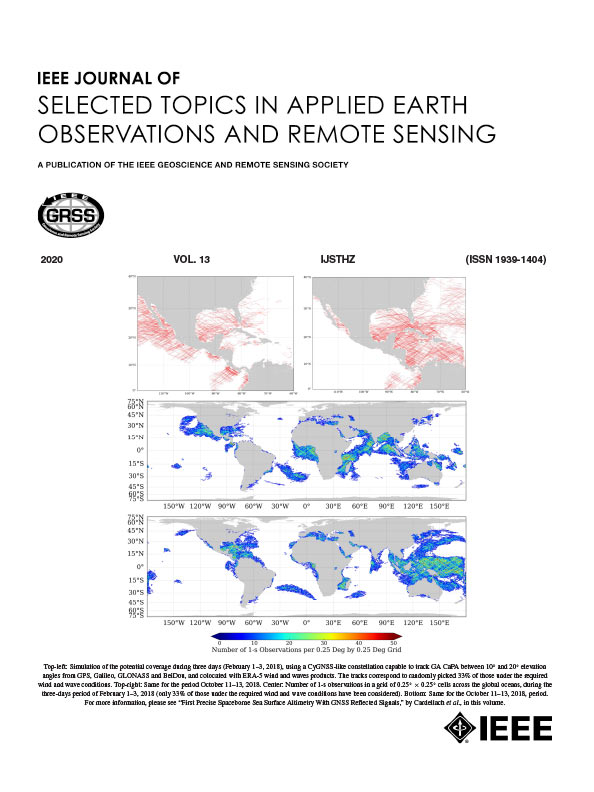Adaptive Early Wildfire Monitoring Based on Spatiotemporal Prediction and Himawari 8/9
IF 4.7
2区 地球科学
Q1 ENGINEERING, ELECTRICAL & ELECTRONIC
IEEE Journal of Selected Topics in Applied Earth Observations and Remote Sensing
Pub Date : 2025-03-26
DOI:10.1109/JSTARS.2025.3554892
引用次数: 0
Abstract
The rapid advancement of deep learning (DL) technology significantly enhances early forest fire detection methods. However, traditional approaches often rely on fixed thresholds and supervised learning techniques, which may fail to account for the complex spatiotemporal dynamics associated with forest fire events. To overcome this limitation, an adaptive DL model is proposed and specifically designed for early forest fire monitoring. This model integrates Stacking ConvLSTM to forecast mid-infrared brightness temperatures and employs a nonparametric dynamic thresholding method based on Otsu's algorithm for spatiotemporal anomaly detection, facilitating the identification of potential hotspots. By effectively capturing complex dependencies within spatiotemporal dimensions, this method improves detection accuracy. Furthermore, high-confidence early fire points are determined through dual-band analysis and land cover detection. Comparative experiments utilizing Himawari-8/9 satellite data reveal that the proposed method outperforms traditional techniques as well as the latest temporal methods, achieving an accuracy of 0.995, precision of 0.985, recall of 0.946, and an F1 score of 0.965. In addition, our method demonstrates an average fire detection delay of just 7 min and an average runtime of 71 s, underscoring its effectiveness in early forest fire detection. This approach serves as a robust tool for enhancing forest fire monitoring systems, offering significant implications for reducing response times and mitigating fire-related damages.基于时空预测和Himawari 8/9的野火自适应早期监测
深度学习(DL)技术的快速发展显著增强了早期森林火灾探测方法。然而,传统方法往往依赖于固定阈值和监督学习技术,这可能无法解释与森林火灾事件相关的复杂时空动态。为了克服这一限制,提出并专门设计了一种用于森林火灾早期监测的自适应深度学习模型。该模型结合Stacking ConvLSTM预测中红外亮度温度,采用基于Otsu算法的非参数动态阈值方法进行时空异常检测,便于潜在热点的识别。该方法通过有效捕获时空维度内的复杂依赖关系,提高了检测精度。此外,通过双波段分析和土地覆盖探测,确定高置信度的早期火点。利用Himawari-8/9卫星数据进行的对比实验表明,该方法的准确率为0.995,精密度为0.985,召回率为0.946,F1分数为0.965,优于传统方法和最新时间方法。此外,我们的方法显示平均火灾探测延迟仅为7分钟,平均运行时间为71秒,强调了其在早期森林火灾探测中的有效性。这种方法是加强森林火灾监测系统的有力工具,对缩短反应时间和减轻与火灾有关的损害具有重要意义。
本文章由计算机程序翻译,如有差异,请以英文原文为准。
求助全文
约1分钟内获得全文
求助全文
来源期刊
CiteScore
9.30
自引率
10.90%
发文量
563
审稿时长
4.7 months
期刊介绍:
The IEEE Journal of Selected Topics in Applied Earth Observations and Remote Sensing addresses the growing field of applications in Earth observations and remote sensing, and also provides a venue for the rapidly expanding special issues that are being sponsored by the IEEE Geosciences and Remote Sensing Society. The journal draws upon the experience of the highly successful “IEEE Transactions on Geoscience and Remote Sensing” and provide a complementary medium for the wide range of topics in applied earth observations. The ‘Applications’ areas encompasses the societal benefit areas of the Global Earth Observations Systems of Systems (GEOSS) program. Through deliberations over two years, ministers from 50 countries agreed to identify nine areas where Earth observation could positively impact the quality of life and health of their respective countries. Some of these are areas not traditionally addressed in the IEEE context. These include biodiversity, health and climate. Yet it is the skill sets of IEEE members, in areas such as observations, communications, computers, signal processing, standards and ocean engineering, that form the technical underpinnings of GEOSS. Thus, the Journal attracts a broad range of interests that serves both present members in new ways and expands the IEEE visibility into new areas.

 求助内容:
求助内容: 应助结果提醒方式:
应助结果提醒方式:


